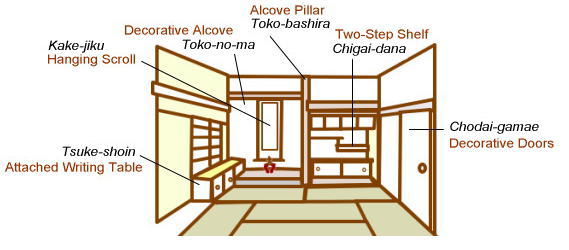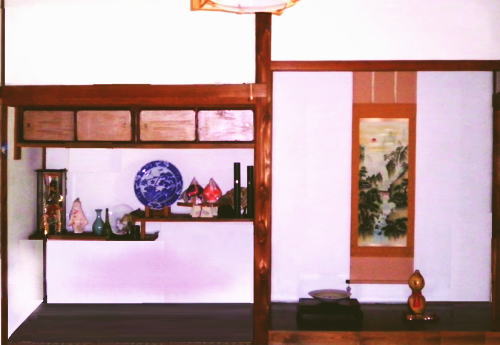Shoin style
Samurai-residence style; traditional Japanese house style

 Shoin literally means “a study or writing room”, and the Shoin style is a reformed version of the Shinden style (aristocratic residence style) in the Heian Period (794 - 1192). As the aristocrat Fujiwara clan, the de facto ruler of the era, was losing their influence, and warrior lords began to replace them, the style gradually gained popularity to become standard in Japan. It eventually developed into a warrior or noble people’s living room/study structure after the Muromachi Period (1334 - 1573). Shoin literally means “a study or writing room”, and the Shoin style is a reformed version of the Shinden style (aristocratic residence style) in the Heian Period (794 - 1192). As the aristocrat Fujiwara clan, the de facto ruler of the era, was losing their influence, and warrior lords began to replace them, the style gradually gained popularity to become standard in Japan. It eventually developed into a warrior or noble people’s living room/study structure after the Muromachi Period (1334 - 1573).

 Its key features include a Toko No Ma or decorative alcove, a Chigai Dana or two-step shelf, a Tsuke Shoin or attached writing table, and a Chodai Gamae or decorative doors. Even though used as decorative elements in architecture today, these units used to serve in a specific way. Its key features include a Toko No Ma or decorative alcove, a Chigai Dana or two-step shelf, a Tsuke Shoin or attached writing table, and a Chodai Gamae or decorative doors. Even though used as decorative elements in architecture today, these units used to serve in a specific way.
 Also employed for temple building, Shoin referred to a private room of a monk, where they had a calm and humble life. They would pay respect to a Buddha image hung on the Toko No Ma wall, place flowers, incense, and light as offering on its raised floor; chant sutras; keep Buddhist scriptures on the shelf; and engage in reading or writing on the attached table. Chodai Gamae once was the doors to a sleeping chamber. Also employed for temple building, Shoin referred to a private room of a monk, where they had a calm and humble life. They would pay respect to a Buddha image hung on the Toko No Ma wall, place flowers, incense, and light as offering on its raised floor; chant sutras; keep Buddhist scriptures on the shelf; and engage in reading or writing on the attached table. Chodai Gamae once was the doors to a sleeping chamber.
|
|




